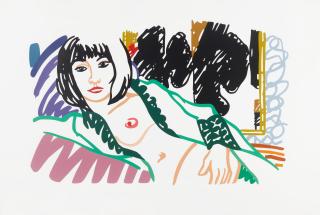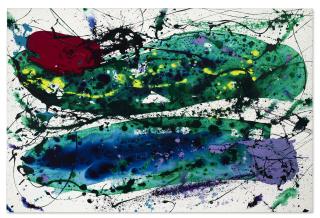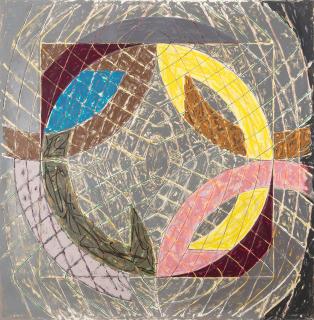Jim Dine born 1935
The artist Jim Dine
- US-american artist and representative of Pop Art who works with various media.
- His hand drawings and prints are some of his best-known works.
- In addition to paintings and drawings, he also creates sculptures, conceptual art and poetry.
The US artist and poet Jim Dine was born on 16.06.1935 in Cincinnati (Ohio) and is considered a representative of Pop Art. From 1953 to 1958 he studied at various universities and finally obtained his bachelor's degree in fine arts at Ohio State University. A year later he moved to New York City, where he founded the Judson Gallery together with Claes Oldenburg, Marc Ratliff and Tom Wesselmann. Here he exhibited and carried out his first happenings with his colleagues. Since Dine worked with various media, he considers himself a cross-genre artist.
In the 1960s, he began to work with poetry in addition to painting, graphic art and sculpture; later (1990), photography was to be added. In this period, brushes and other tools of his trade also found their way into his paintings - he applied them to his canvases. In 1962, Dine participated in his first Pop Art exhibition alongside Roy Lichtenstein and Andy Warhol, and two years later his work was exhibited at the Venetian Biennale. In 1966, Dine worked with Eduardo Paolozzi in London and just four years later, in 1970, the Whitney Museum of American Art (New York) showed Dine's first major retrospective.
In the 1980s, he became increasingly involved in the visual arts and, inspired by the Venus de Milo, created a series of figurative sculptures. Furthermore, another retrospective was held at the Walker Art Center (Minneapolis) in 1984-1985. Internationally recognised and appreciated, his art is now part of the collections of the Centre Pompidou (Paris), both the Metropolitan Museum of Art and the MoMA in New York as well as the Tate Gallery of Modern Art (London).
In art circles, Jim Dine is considered a forerunner of Neo-Expressionism and is associated with Pop Art. This is mainly because he used consumer objects as motifs and, at the end of the 1950s, together with Claes Oldenburg, established the practice of pulling everyday objects out of context and rearranging them. Despite the similarity of his visual language to Pop Art, Dine himself never saw himself as part of it. His artworks include paintings, drawings, photographs, prints and sculptures. They are characterised by their abundance of colours; Pinocchio, hearts, bathrobes and tools are recurring motifs. Everyday objects such as tools, work utensils or items of clothing are also attached to many of his canvases.
Der Künstler Jim Dine
- US-amerikanischer Mixed-Media-Künstler und Vertreter der Pop-Art.
- Seine Handzeichnungen und Druckgrafiken gehören zu seinen bekanntesten Werken.
- Kreiert neben Gemälden und Zeichnungen u. a. auch Skulpturen, Konzeptkunst und Poesie.
Der US-amerikanische Künstler und Dichter Jim Dine wurde am 16.06.1935 in Cincinnati (Ohio) geboren und gilt als Vertreter der Pop-Art. Von 1953 bis 1958 studierte er an verschiedenen Universitäten und erlangte schlussendlich seinen Bachelor in bildender Kunst an der Ohio State University. Ein Jahr später zog er nach New York City, wo er zusammen mit Claes Oldenburg, Marc Ratliff und Tom Wesselmann. die Judson Gallery gründete. Hier stellte er aus und führte mit seinen Kollegen erste Happenings durch. Da Dine mit verschiedenen Medien arbeitete, zählt er sich selbst zu den genre-übergreifenden Künstlern.
In den 1960er Jahren begann er damit, sich neben Malerei, Grafik und Skulptur auch mit Lyrik zu beschäftigen, später (1990) sollte auch die Fotografie hinzukommen. Zudem finden in dieser Zeit Pinsel und andere seiner Arbeitsutensilien Einzug in seine Gemälde – er bringt sie auf seinen Leinwänden an. 1962 nahm Dine neben Roy Lichtenstein und Andy Warhol an seiner ersten Pop-Art-Ausstellung teil, zwei Jahre später wurden seine Werke auf der Venezianischen Biennale ausgestellt. 1966 arbeitete Dine zusammen mit Eduardo Paolozzi in London und bereits vier Jahre danach, 1970, zeigte das Whitney Museum of American Art (New York) Dines erste große Retrospektive.
In den 1980ern befasste er sich dann zunehmend mit der bildenden Kunst und schuf, inspiriert von der Venus von Milo, eine Reihe figürlicher Skulpturen. Zudem fand 1984-1985 im Walker Art Center (Minneapolis) eine weitere Retrospektive statt. International anerkannt und geschätzt sind seine Werke heute Teil der Sammlungen vom Centre Pompidou (Paris), vom Metropolitan Museum of Art sowie dem MoMA in New York und der Tate Gallery of Modern Art (London).
In Kunstkreisen gilt Jim Dine als Vorläufer des Neoexpressionismus und wird der Pop-Art zugeordnet. Das rührt vor allem daher, dass er Konsumobjekte als Motive nutzte und zum Ende der 1950er Jahre zusammen mit Claes Oldenburg das Aus-dem-Kontext-Reißen und Neuanordnen von Alltagsgegenständen etablierte. Trotz der Ähnlichkeit seiner Bildsprache zur Pop-Art sah Dine selbst sich dieser jedoch nie zugehörig. Seine Werke umfassen Gemälde, Zeichnungen, Fotografien, Drucke und Skulpturen. Sie zeichnen sich durch ihre Fülle an Farben aus; Pinocchio, Herzen, Bademäntel und Werkzeuge sind dabei wiederkehrende Motive. Auch Alltagsgegenstände wie Werkzeuge, Arbeitsutensilien oder Kleidungsstücke sind auf vielen seiner Leinwände befestigt.
Jim Dine in a nutshell
Jim Dine is best known for his neo-dadaist artwork. He is a versatile artist who works in a variety of techniques, including painting, drawing, sculpture, photography, and printmaking. One of his most famous series is Hearts, in which he depicts the heart as a universal symbol of love and passion in many different forms and materials. Other recurring motifs in Dine's art include tools such as hammers and wrenches, as well as bathrobes and Pinocchio characters.
The artworks often show a mixture of abstract and figurative elements. His paintings and sculptures are usually characterized by gestural brushstrokes, expressive lines and strong color contrasts. Another important element is Dine's fascination with the creative process and creative work itself. He frequently emphasizes the importance of the artistic process and human manual labor in a world increasingly dominated by machine production and automation.
Since 1970, Dine has been designing his Hearts, of which he claims there are millions. Initially, they stood for his relationship with his wife; over the years, the series evolved into a universal symbol of love. Crucial to the statement of universality is the variation of the hearts in shape and color. Dine also varied the medium, creating paintings and sculptures that are part of the series.
At the age of 25, Jim Dine had his first exhibition in 1960 at the Reuben Gallery in New York. He showed drawings and prints, but the show was most remembered for his performance Car Crash. It lasted about 15 minutes and took place in an all-white room. Dine processed experiences of his own car accidents and performed his fragmentary memories.
Dine artworks are sought after and found in collections of major museums worldwide. Most are in the U.S., for example, the Art Institute of Chicago, the Cleveland Museum of Art, the Guggenheim, the Whitney and the Met, all in New York. In Washington, D. C., Dine is represented at the Hirshhorn Museum and Sculpture Garden and the National Gallery of Art. Outside the U.S., his work can be seen at venues such as the Tokyo Metropolitan Art Museum, the Tate Gallery in London, the Museum Folkwang in Essen, Germany, and the Israel Museum in Jerusalem.
Dine's late work is more strongly influenced by photography, which takes a different direction for him. In this way, he wants to move away from his Pop Art style and create contemporary works. Also important for the late work is Dine's increased reference back to his childhood: the imprint of the Pinocchio figure and his fascination with birds increasingly find their way into his oeuvre.
Häufige Fragen zu Jim Dine
Jim Dine ist vor allem für seine neo-dadaistischen Kunstwerke bekannt. Er ist ein vielseitiger Künstler, der in verschiedenen Techniken arbeitet, darunter Malerei, Zeichnung, Skulptur, Fotografie und Druckgrafik. Eine seiner bekanntesten Serien ist Hearts, in denen er das Herz als universelles Symbol für Liebe und Leidenschaft in vielen verschiedenen Formen und Materialien darstellt. Andere wiederkehrende Motive in Dines Kunst sind Werkzeuge wie Hammer und Schraubenschlüssel, aber auch Bademäntel und Pinocchio-Figuren.
Die Kunstwerke zeigen oft eine Mischung aus abstrakten und figurativen Elementen. Seine Bilder und Skulpturen zeichnen sich in der Regel durch gestische Pinselstriche, expressive Linien und starke Farbkontraste aus. Ein weiteres wichtiges Element ist Dines Faszination für den Schaffensprozess und das kreative Schaffen selbst. Er betont häufig die Bedeutung des künstlerischen Prozesses und der menschlichen Handarbeit in einer Welt, die zunehmend von maschineller Produktion und Automatisierung geprägt ist.
Seit 1970 entwirft Dine seine Hearts, von denen es nach eigenen Angaben Millionen gibt. Anfangs standen sie für die Beziehung zu seiner Frau, im Laufe der Jahre entwickelte sich die Serie zu einem universellen Symbol der Liebe. Entscheidend für die Aussage der Universalität ist die Variation der Herzen in Form und Farbe. Dine variierte auch das Medium und schuf Gemälde und Skulpturen, die Teil der Serie sind.
Im Alter von 25 Jahren hatte Jim Dine seine erste Ausstellung 1960 in der Reuben Gallery in New York. Er zeigte Zeichnungen und Drucke, doch die Schau blieb vor allem wegen seiner Performance Car Crash im Gedächtnis. Sie dauerte etwa 15 Minuten und fand in einem vollständig weißen Raum statt. Dine verarbeitete Erfahrungen eigener Autounfälle und führte seine fragmentarischen Erinnerungen vor.
Dine Kunstwerke sind begehrt und weltweit in Sammlungen bedeutender Museen zu finden. Die meisten liegen in den USA, zum Beispiel das Art Institute of Chicago, das Cleveland Museum of Art, dem Guggenheim, dem Whitney und dem Met, alle in New York. In Washington, D. C. ist Dine im Hirshhorn Museum and Sculpture Garden sowie in der National Gallery of Art vertreten. Außerhalb der USA kann man seine Werke etwa im Tokyo Metropolitan Art Museum, der Tate Gallery in London, dem Museum Folkwang in Essen und dem Israel Museum in Jerusalem sehen.
Dines Spätwerk ist stärker von Fotografie geprägt, die eine andere Richtung für ihn einschlägt. Damit will er sich von seinem Pop-Art-Stil entfernen und aktuelle Werke schaffen. Wichtig für das Spätwerk ist auch Dines verstärkter Rückbezug auf seine Kindheit: die Prägung durch die Pinocchio-Figur und seine Faszination für Vögel finden verstärkt Einzug in sein Œuvre.







































